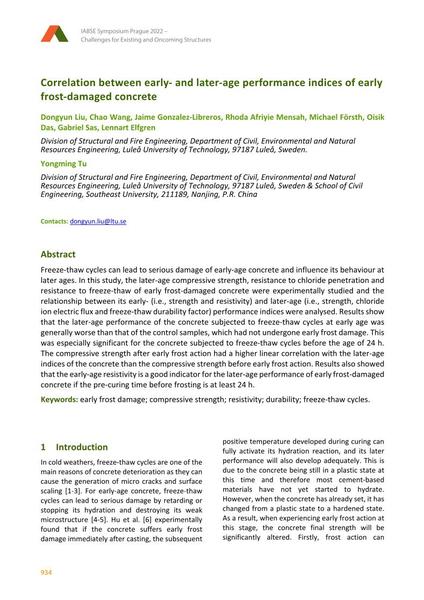Correlation between early- and later-age performance indices of early frost-damaged concrete

|
|
|||||||||||
Détails bibliographiques
| Auteur(s): |
Dongyun Liu
(Division of Structural and Fire Engineering, Department of Civil, Environmental and Natural Resources Engineering, Luleå University of Technology, 97187 Luleå, Sweden.)
Chao Wang (Division of Structural and Fire Engineering, Department of Civil, Environmental and Natural Resources Engineering, Luleå University of Technology, 97187 Luleå, Sweden.) Jaime Gonzalez-Libreros (Division of Structural and Fire Engineering, Department of Civil, Environmental and Natural Resources Engineering, Luleå University of Technology, 97187 Luleå, Sweden.) Rhoda Afriyie Mensah (Division of Structural and Fire Engineering, Department of Civil, Environmental and Natural Resources Engineering, Luleå University of Technology, 97187 Luleå, Sweden.) Michael Försth (Division of Structural and Fire Engineering, Department of Civil, Environmental and Natural Resources Engineering, Luleå University of Technology, 97187 Luleå, Sweden.) Oisik Das (Division of Structural and Fire Engineering, Department of Civil, Environmental and Natural Resources Engineering, Luleå University of Technology, 97187 Luleå, Sweden.) Gabriel Sas (Division of Structural and Fire Engineering, Department of Civil, Environmental and Natural Resources Engineering, Luleå University of Technology, 97187 Luleå, Sweden.) Lennart Elfgren Yongming Tu (Division of Structural and Fire Engineering, Department of Civil, Environmental and Natural Resources Engineering, Luleå University of Technology, 97187 Luleå, Sweden & School of Civil Engineering, Southeast University, 211189, Nanjing, P.R. China) |
||||
|---|---|---|---|---|---|
| Médium: | papier de conférence | ||||
| Langue(s): | anglais | ||||
| Conférence: | IABSE Symposium: Challenges for Existing and Oncoming Structures, Prague, Czech Republic, 25-27 May 2022 | ||||
| Publié dans: | IABSE Symposium Prague 2022 | ||||
|
|||||
| Page(s): | 934-941 | ||||
| Nombre total de pages (du PDF): | 8 | ||||
| DOI: | 10.2749/prague.2022.0934 | ||||
| Abstrait: |
Freeze‐thaw cycles can lead to serious damage of early‐age concrete and influence its behaviour at later ages. In this study, the later‐age compressive strength, resistance to chloride penetration and resistance to freeze‐thaw of early frost‐damaged concrete were experimentally studied and the relationship between its early‐ (i.e., strength and resistivity) and later‐age (i.e., strength, chloride ion electric flux and freeze‐thaw durability factor) performance indices were analysed. Results show that the later‐age performance of the concrete subjected to freeze‐thaw cycles at early age was generally worse than that of the control samples, which had not undergone early frost damage. This was especially significant for the concrete subjected to freeze‐thaw cycles before the age of 24 h. The compressive strength after early frost action had a higher linear correlation with the later‐age indices of the concrete than the compressive strength before early frost action. Results also showed that the early‐age resistivity is a good indicator for the later‐age performance of early frost‐damaged concrete if the pre‐curing time before frosting is at least 24 h. |
||||
| Copyright: | © 2022 International Association for Bridge and Structural Engineering (IABSE) | ||||
| License: | Cette oeuvre ne peut être utilisée sans la permission de l'auteur ou détenteur des droits. |
||||
